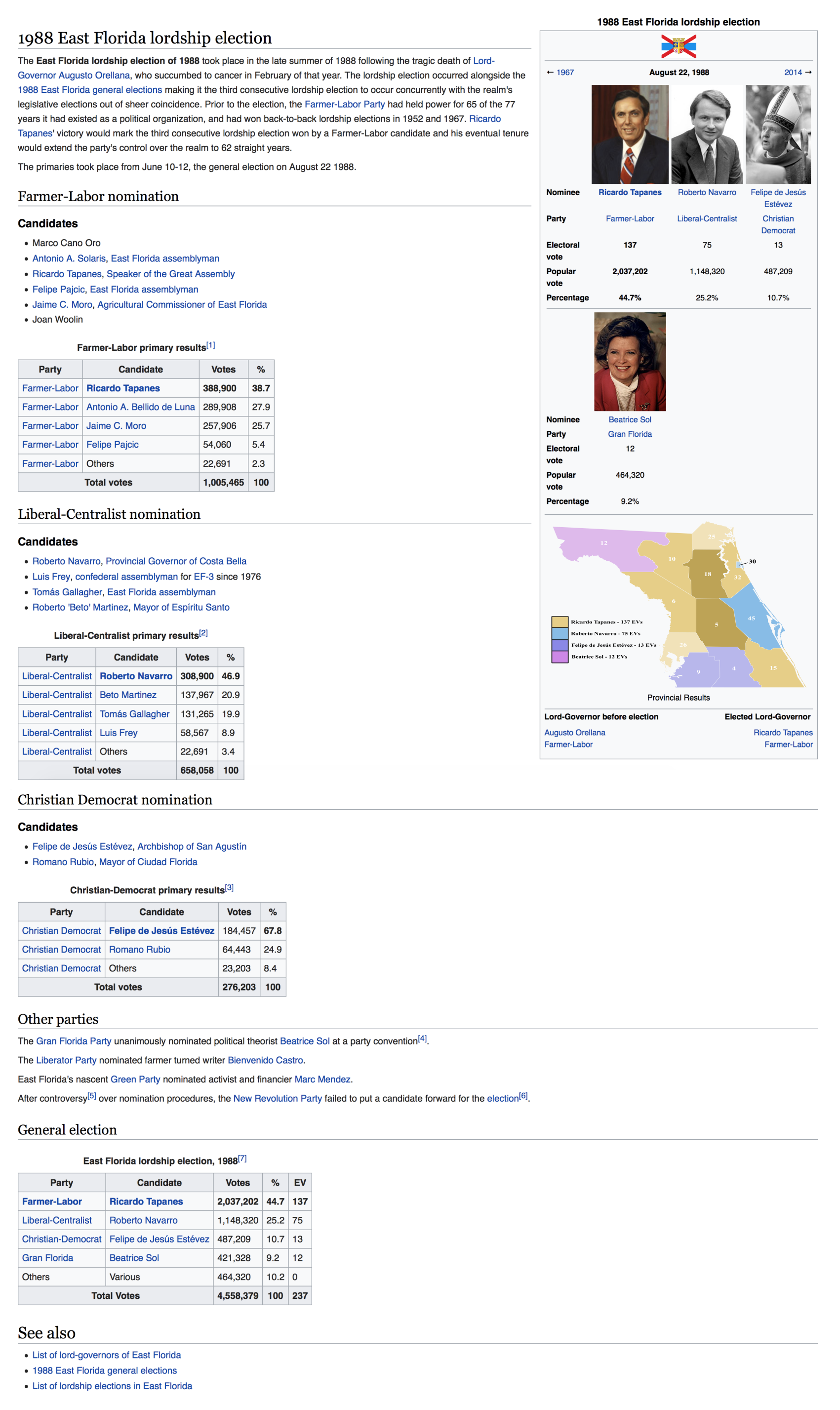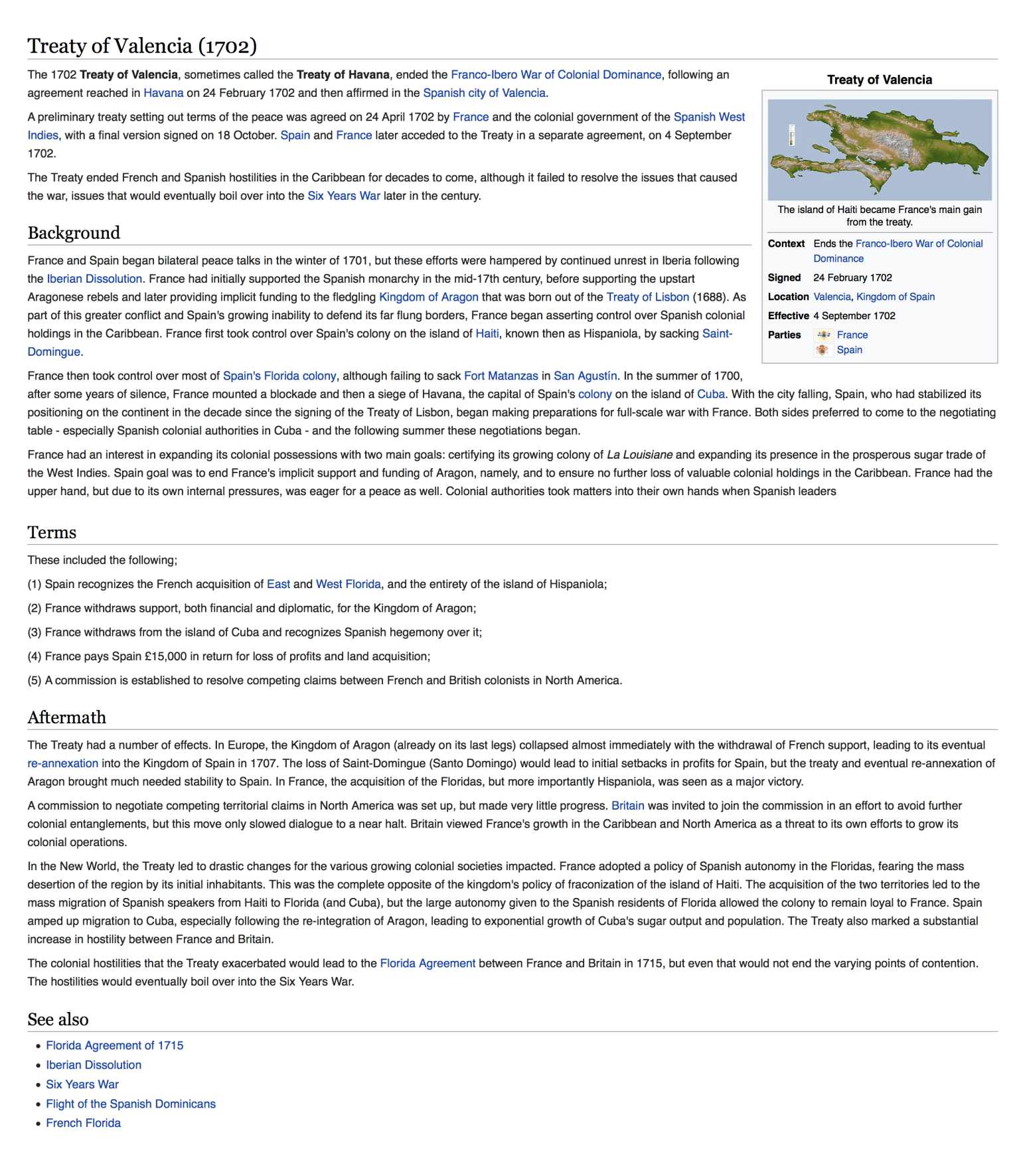List of Lord-Governors of East Florida (Florida Oriental)
As a governate, East Florida elects its executive-for-life after the death of whoever holds the lordship.
- Juan I (Palacios y Valenzuela) | RP: Independent | CA: Realmists | T: 1802-1811 (9) | L: 1749-1826 (62) [1]
- Juan José (de Estrada) | RP: Floridian Party | CA: Realmists | T: 1812-1833 (21) | L: 1766-1833 (67) [2]
- Juan II (Jacobs) | RP: Unionist Party | CA: Centralists | T: 1833-1835 (2) | L: 1781-1835 (53) [3]
- Pedro I (Palacios y Valenzuela) | RP: Floridian Party | CA: Realmists/later also Royalist | T: 1836-1867 (31) | L: 1801-1867 (66) [4]
- Juan III (Quesada) | RP: Agrarian Peoples Party | CA: Realmists/later Agrarian Confederal Coalition | T: 1867-1892 (25) | L: 1825-1892 (67) [5]
- Pedro II (Santana) | RP: Agrarian Peoples Part/later Farmer-Labor Party | CA: United Workers Front | T: 1893-1939 (46) | L: 1858-1939 (80) [6]
- Felipe (González) | RP: Holy Democratic Party | CA: Pan-Realm Confederalist Movement | T: 1939-1952 (12) | L: 1879-1952 (73) [7]
- José Luis (Santana) | RP: Farmer-Labor Party | CA: United Workers Front | T: 1952-1967 (15) | L: 1885-1967 (81)
- Augusto (Orellana) | RP: Farmer-Labor Party | CA: United Workers Front | T: 1967-1988 (11) | L: 1927-1988 (61)
- Ricardo (Tapanes) | RP: Farmer-Labor Party | CA: United Workers Front | T: 1988-2014 (26) | L: 1930-2014 (84) [8]
- Juan Carlos (Alvarado)| RP: Liberal-Centralist Party| CA: Liberal Alliance for Prosperity | T: Incumbent (6) | L: 1967 (53) [9]
[1] Juan I oversaw the
Spanish Rebellion (1774) against British rule over East Florida and then merged his movement into the greater
American Revolution with promises of autonomy and a distaste for rejoining Spain [East Florida hadn't been under Spain's control since the Treaty of Valencia in 1702, despite maintaining a large Spanish population under French rule (1702-1754)]. Juan led the way during the
negotiating period with the confederal government and was emphatically selected as the first Lord-Governor when East Florida was admitted into the confederation in 1802. He died midway during the
War of Georgian Aggression (known as the
Expansion War in Georgia), but his efforts ensured a successful outcome for the realm.
[2] Juan José gained power in the latter half of the
War of Georgian Aggression amidst a wave of realmist support in East Florida. This dispute that crafted his party and his campaign was over less than a year later, however, and Juan José would go on to rule largely peacefully until the
Greater Native War (known confederation wide as the
Floridian First Peoples War) which would ultimately end with the establishment of the Mayaimi Confederacy and the near-forcible removal of natives in East Florida south. In modern times, Juan José has come under considerable scrutiny for his treatment of First Peoples in East Florida, with many dubbing the Greater Native War as a form of coeticide.
[3] Juan II is the only entirely non-Spanish lord-governor in East Florida's history, having been elected after the controversial 1833 election. His reign was tumultuous, and despite historians believing his victory was legitimate, public support for Juan II diminished rapidly. The
Floridian Revolt of 1834-35 resulted in Juan II being captured and hung on claims of aiming to have the Spanish population (vast majority) forcibly removed. Juan II is the only East Floridian lord-governor to be assassinated and his death caused considerable outcry across the Union of American Realms and soured the view of East Florida amongst many other members of the confederation. Juan II holds the record for shortest tenure lord-governor.
[4] The first person elected to the office to have been related to a prior lord-governor. Pedro I's election was nearly as controversial as Juan II's, however the realm largely coalesced under his rule. Despite being ardently on the
realmist side of Executive Council members and being a member of East Florida's realmist Floridian Party, Pedro I spent the vast majority of his tenure rebuilding relations with the rest of the confederation. In the early years, this meant being
royalist, which allowed East Florida to make a number of friends. When the anti-royalist movement peaked in the mid 19th century due to John Augustine I's reign, this
royalist attitude helped him remain loyal back home to his Floridian Party roots, as the anti-royalist movement took a turn for centralism.
[5] Juan III's was the first victory by someone not born a member of the East Florida elite. Under his tenure, slavery was abolished in East Florida, and a strong coalition of agrarian, poor, mestizo and afrofloridian factions emerged.
Quasadianism has significantly shaped East Floridian political discourse and was adopted and then adapted by his successor. Juan III's victory and tenure completely changed East Florida politics, and ushered in an era of left-wing populism that has governed the realm for 135 of the last 151 years.
[6] Pedro II is the most famous East Floridian lord-governor confederation wide without question, having been elected Governor-President of the Union twice. He is the only Governor-President in confederation history to have been re-called, and he was the first Governor-President to regain the title after having lost it. Pedro II holds the record for longest tenure as lord-governor in East Florida at 46 years. Hand in hand, he holds the record for youngest person elected lord-governor in realm history, having been just 35 at the time he assumed the position. Pedro was also the first lord-governor of the Farmer-Labor Party, orchestrating the Agrarian Peoples Party's merger with the growing Workingmans Party in 1911. Adapting his predecessors leftist, populist ideology, Pedro developed his own ideology known as
Santanismo, which blended attitudes of
realmism with
confederationalism, and left-wing populism. To date, he is the only Governor-President in confederation history to have learned a language other than English first.
[7] Felipe is the only lord-governor elected from the Holy Democratic Party (which later became the modern Christian Democratic Party) and his tenure saw consistent conflict between himself and the East Florida legislature, which was staunchly Farmer-Labor throughout most of his time in power.
[8] Ricardo Tapanes is the oldest person to hold the office of lord-governor in East Florida, passing away at the age of 84. His tenure in office is the second-longest behind Pedro II's and marked 62 consecutive years of Farmer-Labor control of the East Florida executive office. The population growth that has occurred in East Florida throughout the 20th century peaked during his tenure as a result of his moderate migration policies and support for immigration into the realm, and stark contrast from his predecessors. This would ultimately hurt his party, however, as the Farmer-Labor Party began losing popularity as the 21st century rolled around.
[9] Juan Carlos became the first non-Farmer-Labor member to be elected to the office since Lord-Governor Felipe, and the first Liberal-Centralist elected in that party's history. Juan Carlos's victory came alongside an astonishing first place showing by his party in the concurrent 2014 East Florida general election and the crafting of a coalition that removed the Farmer-Labor Party from control of the realm's legislature. Juan Carlos's tenure has so far been popular, and his coalition made gains in the 2017 East Florida general election.





